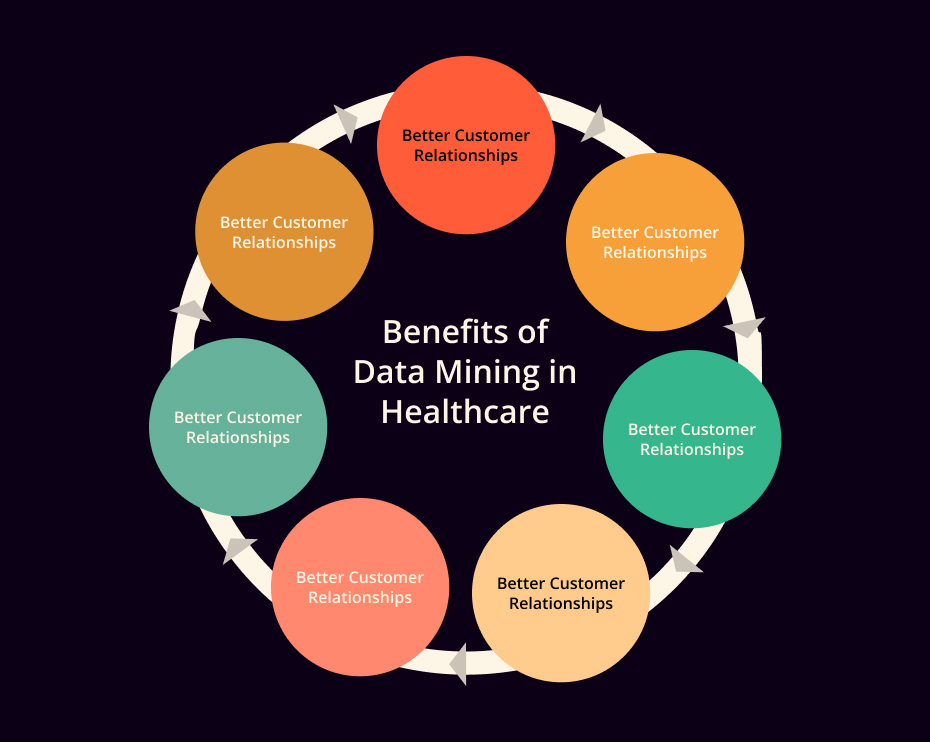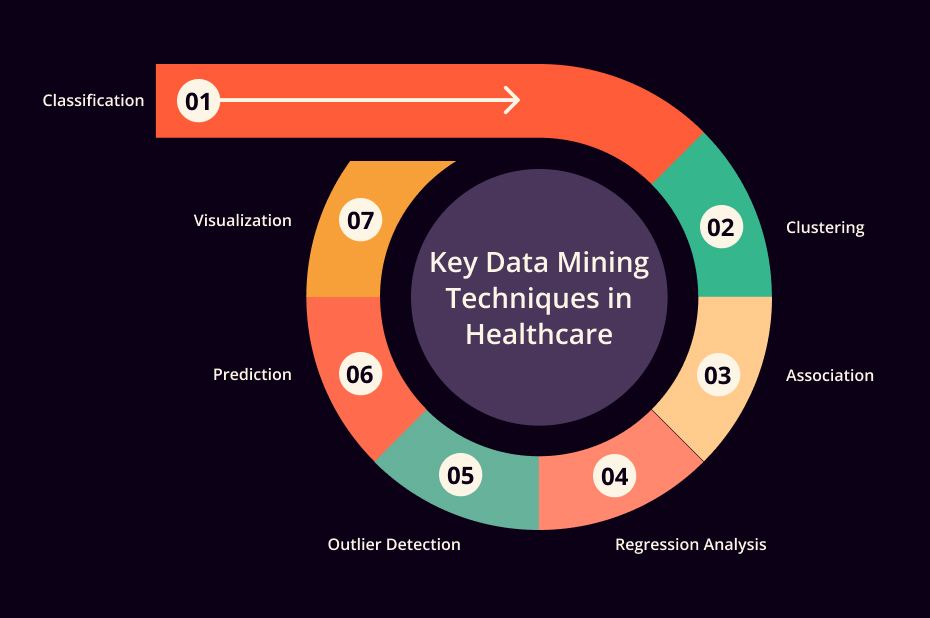The healthcare industry deals with a massive amount of data from EHRs and lab systems to wearable devices and telemedicine apps. With so much information being generated daily, simply storing it isn’t enough. To handle this data flood, hospitals and research centers rely on data mining in healthcare for collection, storage, and analysis.
According to Fortune Business Insights, the worldwide market for data mining tools is anticipated to grow from $1.13 billion in 2024 to $2.99 billion by 2032. Ignoring that potential will be a mixed opportunity for healthcare entities.
As IoT in healthcare and telehealth platforms expand, the volume of health data continues to rise. Medical data mining helps healthcare providers cut costs, detect fraud faster, and improve patient care by turning raw data into actionable insights.
In this article, we’ll break down data mining techniques, explore real business benefits, share practical use cases, and look at the main challenges along with proven solutions. Let’s get started.
What is Data Mining in Healthcare?
Data mining in healthcare goes beyond scanning large datasets. It is a resource-intensive procedure that needs a significant amount of computing and data warehousing capabilities.
Healthcare data mining utilizes different ways of statistical analysis and ML techniques to uncover patterns and connections. This helps doctors, administrators, and researchers make evidence-based, more intelligent decisions in clinical settings.
By transforming raw and siloed data into practical use, hospitals can identify trends early, personalize treatment plans, and manage resources more effectively.
Benefits of Data Mining in Healthcare
In the digital-first era, healthcare generates about 30% of the world’s data, and experts project this will climb to 36% by 2025. Making sense of this fragmented data can give medical organizations a real competitive edge. Here’s how effective clinical data mining can help:

1. Better Customer Relationships
Adding a data mining layer to your healthcare CRM software isn’t just an upgrade. It transforms how you serve patients.
- CRM systems can match patients to specialists with the right expertise and availability. This leads to better care and higher satisfaction.
- By analyzing data from similar cases, hospitals can predict complications and recovery timelines. This helps plan follow-ups and lowers readmission rates.
- Tracking pharmacy purchases through CRM shows whether patients stick to treatment plans. Doctors can step in sooner when needed.
Ultimately, big data and data mining in healthcare improve outcomes and earn patient trust. It’s not just about having more data, it’s about using it to create real, measurable value.
2. Accurate Disease Diagnosis
Data mining in healthcare helps doctors make evidence-backed diagnoses. Big data and AI in healthcare can scan MRI images, blood tests, and patient histories in seconds. They highlight patterns doctors might not spot right away.
While experienced clinicians still make the final call, this speed and depth of analysis support earlier detection of complex and life-threatening conditions. Quick, accurate insights can change outcomes for patients with hard-to-diagnose symptoms.
3. Smarter Clinical Decision-making
More hospitals now rely on clinical decision support systems (CDSS) to guide treatment choices. Some use rule-based logic, while others lean on machine learning development.
Data mining in medical field boosts CDSS systems by comparing patient records with recent studies and similar case histories. This helps doctors choose treatments grounded in real-world data and fact-based research. Ultimately, it leads to more personalized and effective care decisions.
4. Streamlined Administrative Processes
Data mining in healthcare industry helps teams cut through paperwork by automating routine tasks like billing, claims review, and patient scheduling. It identifies process bottlenecks and offers data-backed solutions.
This data mining benefits help hospitals to reallocate staff time toward patient care instead of administrative work. This improves efficiency and reduces costly operational delays.
5. Predictive Health Insights
Setting aside extra resources for predictive analytics in healthcare might seem expensive, but it pays off quickly. With properly built software, the cost of data mining stays reasonable while unlocking real, measurable benefits. By combining data intelligence services with predictive analytics, healthcare organizations can do far more than react to problems after they appear.
For example, healthcare providers can:
- Prepare for spikes in seasonal and other infections by analyzing historical and real-time data trends.
- Avoid staff shortages and drug understocking through smarter forecasting and inventory planning.
- Proactively implement new technologies and phase out outdated practices based on the data’s findings.
Therefore, by turning raw data into clear predictions, healthcare providers can make faster, evidence-based decisions. This improves patient outcomes, reduces costs, and maintains resilient care delivery.
6. Avoid Harmful Drug Interactions
Some medications can lose effectiveness or cause side effects when combined with other drugs or certain foods. The FDA advises patients to consult healthcare professionals before starting a new drug, but real-world pressures often make that hard.
One of the significant advantages of data mining in healthcare is that it reviews chemical data and the latest clinical research, and flags potential risks faster than manual checks. This protects doctors, nurses, and patients alike by reducing errors and creating personalized treatment plans.
7. Lower Costs & Readmissions
Health care data mining analyzes historical and patient data to reveal patterns behind readmissions and unnecessary tests. Hospitals can then target those risks with preventive care plans and better discharge strategies. This not only lowers healthcare app development costs but also improves long-term patient outcomes.
Apart from that, it identifies which treatments yield the best results for specific patient groups. Over time, these valuable insights will support more innovative budgeting, effective resource allocation, and even more personalized care.
Key Data Mining Techniques in Healthcare
The range of healthcare data mining techniques is broad, but let’s focus on those most widely used. At the core, each method relies on mathematical analysis to detect patterns and hidden relationships within large data sets.

1. Classification
Classification algorithms help categorize big data into specific groups based on defined criteria. For example, they can reveal links between diabetes indicators and certain gut microbiota.
Popular methods include support vector machines, artificial neural networks, and decision trees. These tools guide clinicians to make faster, evidence-based decisions.
2. Clustering
Clustering is different because it works without predefined categories. Instead, it groups data points by similarities it identifies on its own. This approach is especially useful when the nature of the data isn’t fully known.
This data mining technique in healthcare segments patients based on factors such as age, gender, and condition severity. A common method here is K-means clustering, known for its speed and efficiency.
Clustering helps improve patient care, streamline operations, and support research. Ultimately, using the best data mining methods adds measurable value to clinical and business strategies alike.
3. Association
As the name implies, these algorithms search for hidden links among different data attributes. Think of uncovering connections between eating habits and hypertension. Once a rule is established, it helps identify similar patterns in new datasets.
4. Regression Analysis
Regression analysis predicts outcomes by measuring relationships between variables, like how age and lifestyle affect recovery time. Healthcare teams use it to forecast treatment costs and plan resources more accurately.
5. Outlier Detection
This data mining technique spots irregular data points that don’t fit expected trends. It helps remove noise or irrelevant records that could distort the analysis. By filtering out these anomalies, data mining scientists keep results more accurate and reliable.
6. Prediction
Prediction combines insights from other techniques to forecast outcomes using historical and current data. For instance, comparing a patient’s medical history with recent test results can estimate the risk of disease recurrence. The random forest algorithm is widely used here because it handles complex data effectively.
7. Visualization
Visualization turns complex data into clear charts and dashboards. It helps doctors, administrators, and researchers spot patterns quickly. This supports faster clinical decisions, better reporting, and more persuasive communication of insights.
Examples of Data Mining in Healthcare Industry
How can you actually use data mining in healthcare? Hospitals, clinics, and public health centers can all apply it to speed up analysis and reveal hidden trends. When licensed medical experts use advanced data mining tools, they gain real insights quickly without complex manual work. Let’s explore some data mining in healthcare examples.
1. Brain Tumor Detection and Segmentation
Health data mining uses deep learning models trained on thousands of annotated scans. These models quickly analyze MRI data to locate tumor boundaries with impressive precision. Unlike manual review, this process delivers pixel-level accuracy and consistency every time.
Data mapping in healthcare supports:
- Objective measurement of tumor volume changes over time
- Automated workflow integration to reduce radiologist workload
- Clear, visual outputs to aid surgical teams
Real-world data mining examples in healthcare include Siemens Healthineers. The company developed AI-powered imaging tools that help radiologists automatically segment brain tumors.
2. Epidemiology, Trends, and Prognosis Analysis
In this, big data and data mining track disease patterns and forecast outcomes across large populations. It helps healthcare organizations spot risks earlier and allocate resources more effectively.
Key advantages include:
- Detects emerging disease hotspots in real time
- Predicts patient survival rates based on clinical variables
- Supports public health planning with evidence-backed data
Data mining in healthcare use cases continues to scale. For example, BlueDot utilizes AI and big data in healthcare to monitor global trends in infectious diseases. Hospitals and governments rely on their insights to prepare for outbreaks sooner.
3. Personalized Medicine & Genomic Data Analysis
It combines patient genetic profiles with clinical data to tailor treatments that fit individual biology. Instead of one-size-fits-all care, this use of data mining in healthcare predicts how patients respond to drugs and disease risk.
Critical use cases of data mining in medical field include:
- Designing targeted therapies that boost treatment success
- Reducing adverse drug reactions by identifying genetic markers
- Accelerating clinical research through more precise cohorts
For instance, Foundation Medicine, whose genomic testing helps oncologists match cancer patients with targeted therapies.
4. Automated Diagnostics and Research Insights
One significant application of data mining in healthcare is automated diagnostics. It uses AI and big data analytics services to analyze clinical data, images, and lab results faster than manual review. This speeds up detection, reduces errors, and uncovers new research findings.
The top benefits include:
- Faster diagnosis through real-time data analysis
- Consistent results that reduce human variability
- Discovering hidden disease correlations for research
For example, PathAI, whose AI models help pathologists detect cancer in biopsy slides with high accuracy. Clinics using PathAI report quicker turnaround times and more reliable results.
5. Hospital and Pharmacy Operations Optimization
Another example of data mining is the optimization of hospital and pharmacy operations. It uses predictive analytics to improve daily processes, cut waste, and boost service quality.
Crucial advantages include:
- Predicting medicine demand to reduce stockouts and overstock
- Improving staff scheduling based on patient flow trends
- Lowering supply chain costs with data-driven planning
A company named Cerner, whose data analytics solutions help hospitals forecast patient admissions and manage pharmacy inventories. Hospitals using Cerner report fewer medication shortages and more efficient staffing.
6. Analyzing Dietary and Nutrition Patterns
This applies data mining to food intake records, biometric data, and lifestyle information. It helps providers and researchers understand how eating habits impact health outcomes and chronic disease risk.
Key business benefits include:
- Identifying nutrient deficiencies across specific populations
- Designing personalized diet plans that improve adherence
- Predicting diet-related disease risks like diabetes or hypertension
Nutrino developed an AI tool that recommends meals based on an individual’s metabolic data and preferences. Healthcare providers and wellness platforms using Nutrino’s insights offer patients smarter, more engaging nutrition plans.
7. Health Insurance Fraud Detection
Health insurance fraud detection uses data mining and machine learning to identify unusual patterns in claims data that may signal fraudulent activity. Modern health insurance software solutions enable insurers to move beyond manual audits by analyzing thousands of transactions in real time.
Top benefits include:
-
Detecting fraudulent claims before payouts
-
Prioritizing high-risk cases for human review
-
Improving compliance with regulatory requirements
A real-world example is Optum, which provides fraud analytics solutions through advanced flags suspicious claims for insurers efficiently.
How to Implement Data Mining in a Healthcare Organization?
Computing technology has become essential. The power of cloud computing combined with self-learning artificial intelligence development is what makes modern medical data mining possible. Real, well-organized data is what trains these models to spot patterns and deliver insights that actually matter.
When everything is in place, data mining in healthcare usually follows these key stages:
1. Acquisition/Selection
Here, teams create the target dataset by collecting original, relevant data.
2. Preprocessing
Data is cleaned, formatted, and standardized to improve accuracy.
3. Mining
This is the core step, where algorithms search for meaningful patterns and relationships.
4. Interpretation
Finally, insights are extracted and turned into practical strategies and business decisions.
These are the building blocks of data mining in health care. It may look straightforward, but there’s an important layer businesses can’t overlook.
Healthcare organizations must meet strict rules on personal data protection. For the US market, compliance with HIPAA is essential to adopt strong cybersecurity practices from the outset, thereby avoiding breaches and protecting patient trust.
Challenges of Data Mining in Healthcare and Their Solutions
Data mining in healthcare brings powerful opportunities, but real-world challenges remain. Let’s explore the most common obstacles organizations face and practical, industry-tested solutions to overcome them effectively.
Challenge | Description | Practical Solution |
| Data Privacy and Compliance | Strict regulations like HIPAA protect patient data. | Use encryption, access controls, and regular audits to stay compliant. |
| Inconsistent or Poor-Quality Data | Disparate systems create incomplete or inaccurate datasets. | Standardize data collection and invest in quality validation tools. |
| Integration with Legacy Systems | Older software often resists modern analytics tools. | Use middleware APIs and legacy app modernization to bridge old and new. |
| Shortage of Skilled Professionals | Data science talent is limited in healthcare. | Partner with specialized vendors and invest in ongoing team training. |
| High Implementation Costs | Advanced analytics require a significant initial investment. | Start small with pilot projects and scale based on ROI and needs. |
Future of Data Mining in Healthcare
As healthcare data mining becomes more advanced and widely adopted, providers stand to unlock even greater value. Looking ahead, several trends are set to shape the industry and bring a measurable impact:
- Better revenue cycle management for hospitals and clinics
- Improved care for rare diseases through data-driven research
- Higher survival rates for cancer patients thanks to predictive models
- Enhanced quality of care via healthcare app development to underserved populations
- Nationwide prevention strategies against infectious diseases
Data mining is already transforming healthcare in ways that matter. With machine learning, more data can be aggregated and analyzed in real time. As a result, the entire sector becomes more agile and prepared to handle data mining challenges in healthcare as they arise.
How SparxIT Delivers High-Quality Data Mining Solutions for Healthcare?
Currently, hospitals, insurers, and clinical teams require a leading data mining company to identify patterns, predict patient risks, and refine treatment strategies. It’s about transforming untapped data into measurable results that save costs and improve care.
At SparxIT, we bring precision to every project. Our team designs HIPAA-compliant data mining solutions that integrate seamlessly with your EHR/EMR, claims, and lab systems. From predictive analytics to automated diagnostics, we help you make data-driven decisions that are grounded in accuracy and speed.
Partnering with us isn’t just about technology. It’s about strategy, scalability, and proven outcomes. As a trusted healthcare app development company, we don’t just implement tools; we deliver solutions that drive higher ROI.

Partner with Experts
Frequently Asked Questions
How can data mining be used in healthcare?







Healthcare organizations use data mining in healthcare to predict disease risk, personalize treatment plans, detect fraud, and improve hospital efficiency by uncovering hidden patterns in clinical and operational data.
Why is data mining important in healthcare?












The importance of data mining in healthcare is that it turns complex patient data into actionable insights. It improves diagnosis accuracy, patient outcomes, cost efficiency, and evidence-based clinical decisions.
How much does it cost to implement data mining in healthcare?












The healthcare data mining cost varies widely, typically ranging from $35,000 to $350,000, depending on project scope, data complexity, compliance requirements, and technology integration needs.
How long does it take to integrate data mining solutions in healthcare?












Implementing data mining healthcare solutions generally takes 3 to 9 months. Timelines depend on data quality, system complexity, team expertise, and the customization level required.
How does big data enhance data mining applications in the healthcare industry?












Big data in healthcare expands data mining capabilities by providing real-time, large-scale data sets. This helps uncover deeper trends, predict outcomes faster, and support more personalized, data-driven patient care.




